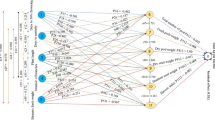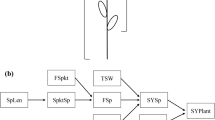Abstract
Development of newly rye cultivars needs efficient tools to manage trait correlation in a breeding program which depends on the direction of the association between yield and its components. In this study, 64 rye genotypes obtained from Institute of Plant Genetics and Crop Plant Research in Gatersleben, Germany (IPK) were evaluated under rainfed conditions in 2016 and 2017 growing seasons. Trials were conducted in a simple lattice design and path analysis used to determine the interrelationships among seed yield and the other 17 yield components and morphological traits. Correlation coefficient analysis revealed seed yield was positively correlated with spike weight, weight of seeds per spike, seed number per spike and number of spike per area across 2 years. The number of spike per area and weight of seeds per spike traits as first-order variables involved in the research of observed variation of seed yield in both years. Although, second-order and third-order variables in both years had some differences but four traits (spike length, spike weight, seed number per spike and thousand seed weight) were similar in years 2016 and 2017. All direct effects were significant, as indicated by bootstrap analysis. For breeders should focus on increasing spike weight and seed number per spike following to spike length and thousand-seed weight for increasing seed yield potential of rye. Our results will allow plant breeders to more efficiently increase rye seed yield in breeding programs.


Similar content being viewed by others
References
Abel S, Gislum R, Boelt B (2017) Path and correlation analysis of perennial ryegrass (Lolium perenne L.) seed yield components. J Agron Crop Sci 203:338–344
Akcura M (2011) The relationships of some traits in Turkish winter bread wheat landraces. Turk J Agric For 35:115–125
Akhavan A, Saeidi H, Rahimineja MR (2010) Genetic diversity of Secale cereale L. in Iran as measured using microsatellites. Genet Resour Crop Evol 57:415–442
Alkimova OG, Mazurok NA, Potapova TA, Zakian SM, Heslop-Harrison JS, Vershinin AV (2004) Diverse patterns of the tandem repeats organization in rye chromosomes. Chromosoma 113:42–52
Araus JL, Bort J, Steduto P, Villegas D, Royo C (2003) Breeding cereals for Mediterranean conditions: ecophysiological clues for biotechnology application. Ann Appl Biol 142(2):129–141
Behre KE (1992) The history of rye cultivation in Europe. Veg Hist Archaeobot 1:141–156
Bhushan B, Bharti S, Ojha A, Pandey M, Gourav SS, Tyagi BS, Singh G (2013) Genetic variability, correlation coefficient and path analysis of some quantitative traits in bread wheat. J Wheat Res 5:24–29
Bocianowski J, Górczak K, Nowosad K, Rybiński W, Piesik D (2016) Path analysis and estimation of additive and epistatic gene effects of barley SSD lines. J Integr Agric 15:1983–1990
Bolibok H, Rakoczy-Trojanowska M, Hromada A, Pietrzykowski R (2005) Efficiency of different PCR- based marker systems in assessing genetic diversity among winter rye (Secale cereale L.) inbred lines. Euphytica 146:109–116
Dreccer MF, Molero G, Rivera-Amado C, John-Bejai C, Wilson Z (2019) Yielding to the image: how phenotyping reproductive growth can assist crop improvement and production. Plant Sci 282:73–82
FAOSTAT (2017) Database of FAO (Food and Agriculture Organization). http://www.faostat.fao.org, Accessed 29 March 2018
Gulmezoglu N, Alpu O, Ozer E (2010) Comparative performance of triticale and wheat grains by using path analysis. Bulg J Agric Sci 16:443–453
IBM SPSS (2013) IBM SPSS statistics for windows, version 22.0. Armonk, NY, USA
Janmohammadi M, Sabaghnia N, Nouraein M (2014) Path analysis of grain yield and yield components and some agronomic traits in bread wheat. Acta Univ Agric Silvic Mendel Brun 62:945–952
Khan MH, Dar AN (2010) Correlation and path coefficient analysis of some quantitative traits in wheat. Afr Crop Sci J 18:9–14
Kozak M, Kang MS (2006) Note on modern path analysis in application to crop science. Commun Biometry Crop Sci 1:32–34
Laidig F, Piepho HP, Rentel D, Drobek T, Meyer U, Huesken A (2017) Breeding progress, variation, and correlation of grain and quality traits in winter rye hybrid and population varieties and national on-farm progress in Germany over 26 years. Theor Appl Genet 130(5):981–998
Leilah AA, Al-Khateeb SA (2005) Statistical analysis of wheat yield under drought conditions. J Arid Environ 61:483–496
Mądry W, Studnicki M, Rozbicki J, Golba J, Gozdowski D, Pecio A, Oleksy A (2015) Ontogenetic-based sequential path analysis of grain yield and its related traits in several winter wheat cultivars. Acta Agric Scand 65:605–618
Mishra Y, Shukla RS, Rawat GS (2001) Correlation coefficients and selection indice sin bread wheat (T. L.) under different growing situation. Indian J Agric Res 35:161–165
Persson K, von Bothmer R, Gullord M, Gunnarsson E (2006) Phenotypic variation and relationships in landraces and improved varieties of rye (Secale cereale L.) from northern Europe. Genet Resour Crop Evol 53:857–866
Protic R, Todorovic G, Protic N, Kostic M, Delic D, Filipovic M, Ugrenovic V (2013) Variation of grain weight per spike of wheat depending on variety and seed size. Rom Agric Res 30:51–55
Sadras VO, Slafer GA (2012) Environmental modulation of yield components in cereals: heritabilities reveal a hierarchy of phenotypic plasticities. Field Crops Res 127:215–224
Samonte SOPB, Wilson LT, Mcczlung AM (1998) Path analyses of yield and yield related traits of fifteen diverse rice genotypes. Crop Sci 38:1130–1136
Shang H, Wei Y, Wang X, Zheng Y (2006) Genetic diversity and phylogenetic relationships in the rye genus Secale L. (rye) based on Secale cereale microsatellite markers. Genet Mol Biol 29:685–691
Skuza L, Rogalska S, Bocianowski J (2007) RFLP analysis of mitochondrial DNA in the genus Secale. Acta Biol Cracoviensia Ser Bot 49:77–87
Vavilov NI (1992) Origin and geography of cultivated plants, English edn. Cambridge University Press, Cambridge, pp 79–93
Acknowledgements
Sincere gratitude goes to Genebank Department of Leibniz Institute of Plant Genetics and Crop Plant Research (IPK; Institut für Pflanzengenetik und Kulturpflanzenforschung) in Gatersleben, Germany for providing plant materials.
Author information
Authors and Affiliations
Corresponding author
Additional information
Publisher's Note
Springer Nature remains neutral with regard to jurisdictional claims in published maps and institutional affiliations.
Rights and permissions
About this article
Cite this article
Nouraein, M. Elucidating seed yield and components in rye (Secale cereale L.) using path and correlation analyses. Genet Resour Crop Evol 66, 1533–1542 (2019). https://doi.org/10.1007/s10722-019-00813-6
Received:
Accepted:
Published:
Issue Date:
DOI: https://doi.org/10.1007/s10722-019-00813-6




